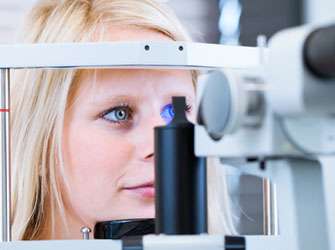200 years of the eye clinic: Diseases of the retina can be predicted

Using optical coherence tomography (OCT), diseases of the retina such as age-related macular degeneration, diabetic retinopathy or vascular occlusions can be predicted before symptoms develop. OCT has been developed in collaboration between the Department of Ophthalmology and the Centre for Medical Physics and Biomedical Technology at the MedUni Vienna and is being constantly improved by the ophthalmologists and physicists working there. "Vienna is helping the world to see better," said Head of Department Ursula Schmidt-Erfurth on the occasion of the 200-year anniversary of the eye clinic at the MedUni Vienna and the Vienna General Hospital - the first worldwide to have been founded as an academic institution.
With OCT, it is possible to detect diseases of the retina in high-resolution detail and while they are still at a very early stage. "This means we are able to look directly into the layers of the retina non-invasively and detect even the tiniest changes early," says Schmidt-Erfurth. Optical coherence tomography is an imaging method which, similar to ultrasound technology but without physical contact, can produce high-resolution sectional images of biological tissue and be regarded as an "optical biopsy".
Three-dimensional representations of the sensitive retinal tissue using the grid-scanning method involve hundreds of scans and can produce a reconstruction of the entire centre of the retina, the point at which our visual acuity is highest, in one to two seconds.
Macular degeneration: OCT reduces the risk of blindness
"Around 2.5 million people every year develop macular degeneration and diabetes-related retinopathy worldwide," says Schmidt-Erfurth. "With the aid of OCT, we are able to completely push back AMD, the most common cause of blindness, since prognosis options have improved markedly over recent years and continue to improve further." Before OCT, around 20 per cent of patients with this condition worldwide went blind; now, however, it is only two per cent.
Around 30,000 people a year are investigated at the University Department of Ophthalmology at the MedUni Vienna and Vienna General Hospital, the largest in Europe, with OCT. Optical coherence tomography not only permits early and precise diagnosis, but can also guide more efficient and personalised treatment with antibodies, so that injections into diseased eyes can be used in a targeted manner.
Virtually everyone, says the head of department, will develop some form of retinal disease during the course of their lifetime. "The older we get, the more likely it is to happen." The conditions begin slowly and are already detectable in the retina long before the patient actually notices anything. Consequently, the MedUni Vienna scientist recommends regular screening with ophthalmologists, especially for at-risk groups such as people with diabetes or high blood pressure, people who are over the age of 50 or people who smoke.
Vienna Reading Center: Expertise for the world
The leading international position of Vienna's Department of Ophthalmology is underpinned by the Vienna Reading Center (VRC), which was founded by Ursula Schmidt-Erfurth in 2005. Study results for the development of new treatments are collated here based on thousands of retina data records from over 200 international study centres and analysed in line with the requirements of the European (EMA) and American (FDA) approvals authorities.
The VRC is currently cooperating with over 1,400 researchers from 280 cities and is the leading centre of its kind outside the USA. The quality of its analyses, which is already excellent, is being improved further with the development of special computer algorithms. From 1st January 2013, a new Christian Doppler Laboratory led by Schmidt-Erfurth will be established in the VRC with funding worth Euro 3 million. This is the eleventh CD laboratory at the MedUni Vienna and will focus on "ophthalmological imaging and processing, self-learning systems and population-based analyses of the most common retinopathies of the modern age."



















